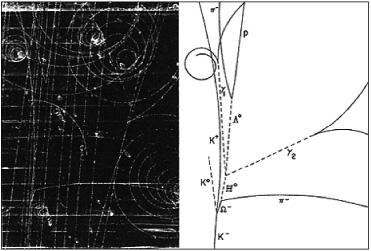125 Physics Projects for the Evil Genius (74 page)
Read 125 Physics Projects for the Evil Genius Online
Authors: Jerry Silver

Figure 125-4
Zigzag path of slow moving low-energy charged particles
.
Collisions occur that either change the motion of the particle or result in a subatomic event, which results in a whole new mix of particles. The laws of conservation of momentum and mass must be followed, which helps to identify the particles, including those that are not visible. Nonionized particles, such as neutrons, will not leave a visible track.
Figure 125-5
shows a sampling of particle collisions in a more elaborate detection system, called a
bubble chamber
.
A muon is one of many types of subatomic particles that may be detected by your cloud chamber. A muon has the same charge as an electron, but it is 207 times more massive. Muons are created when cosmic rays strike the upper layers of the Earth’s atmosphere. Muons are unstable and disintegrate into other particles almost immediately.
After being created at the top of the atmosphere, muons decay within 2.2 microseconds or 0.0000022 second. A
microsecond
is one-millionth of a second. In this time, the muon would travel only 659 meters (0.659 km). Because they are created between 10 and 15 km above the surface of the Earth, most muons would decay before reaching the surface of the Earth. The trouble is how is it even possible that muons are able to travel the distance from where they are created at the top of the atmosphere to the ground before decaying? Even traveling at over 99 percent of the speed of light, the muons do not have enough time to make it to the ground. We should not see any muons at all.

Figure 125-5
Subatomic particle tracks. Courtesy Brookhaven National Labs
.
However, because the muons are traveling so fast—according to Einstein’s theory of relativity—time slows down for them. The fact that we can observe muons at the surface of the Earth serves as proof of Einstein’s theory, which states that the time for the moving particle is

where
t
is the time the muon takes as observed from the Earth,
t
o
is the time it would take for a stationary muon,
v
is the speed of the particle which, in this case, is 0.99c, and
c
is the speed of light. When viewed through the perspective of Einstein’s theory, the muon’s lifetime becomes larger (35 microseconds), which gives it enough time to make it through the Earth’s atmosphere before decaying.
Another track you may see is that of a positron, which is more difficult to distinguish from other positively charged particles. However, just knowing that many of the cloud chamber events are positrons is significant in itself. A positron is the antimatter version of an electron. Now, before you dismiss this as a far-fetched contribution from science fiction, the positron is very commonly found in collision fragments from cosmic rays. (By the way, if you are a science-fiction fan, antimatter plays a prominent role in Dan Brown’s
Angels and Demons
.) When a positron collides with an electron, the two annihilate each other and release energy. Although it may be difficult to identify this event, your cloud chamber positron-electron annihilations are common. This subatomic particle process has actually been developed into a useful application in the form of the PET scanners found in many medical imaging labs. The
P
in PET stands for “positron.” Today, the PET scans enable medical researchers and diagnosticians to image functions, such as the metabolism of malignant tumors and the early diagnosis of Alzheimer’s disease, and to identify risk factors for heart conditions.
Although the technological applications of positron annihilation are complex, they are the same events you can observe taking place in your cloud chamber.
(Background on subatomic particles and their detection was derived from the following source, which is recommended for further information on this topic: “Cloud Chambers and Cosmic Rays, A Lesson Plan and Laboratory Activity for the High School Science Classroom,” Cornell University, Laboratory for Elementary Particle Physics, 2006, available from
http://www.lepp.cornell.edu/Education/rsrc/LEPP/Education/TeacherResources/cloudchamber.pdf
.)
Cosmic rays, consisting of charged subatomic particles, are continuously striking the Earth’s surface. These particles can be detected by observing the tracks they leave in a supersaturated vapor in a device called a cloud chamber.
Where to Get Stuff
PASCO Scientific
10101 Foothills Blvd.
Roseville, CA 95747-7100
1-800-772-8700
www.pasco.com
Sargent-Welch
P.O. Box 4130
Buffalo, NY 14217
1-800-727-4368
www.sergentwelch.com
Flinn Scientific, Inc
.
P.O. Box 219
Batavia, IL 60519
1-800-452-1261
www.flinnsci.com
Frey Scientific
c/o School Specialty Science
80 Northwest Blvd.
Nashua, NH 03063
1-800-225-3739
www.freyscientific.com
Edmund Scientific
60 Pearce Ave.
Tonawanda, NY 14150
1-800-728-6999
www.scientificsonline.com
Daedalon Corporation
P.O. Box 727
Waldoboro, Maine 04572
1-800-299-5469
www.daedalon.com
RadioShack
www.radioshack.com
(More Than) Enough Physics to Get By. (Highly Optional)
Project 1
v = Δd/Δt
Project 2
d = d
o
+ vt
Project 3
d = d
o
+ v(t – t
o
)
Project 5
F = ma
Project 8
Project 9
v = R / t
R = (v
2
/g)sin 2θ
h = (v sin θ)
2
/2g
Project 10
v
x
= R/t
Project 13
Project 17





